Every collector dreams of finding that one special coin hiding in plain sight—and wheat pennies offer some of the most exciting opportunities in American numismatics.
Between 1909 and 1958, the U.S. Mint produced billions of Lincoln cents, but mechanical failures, worn dies, and human error occasionally created fascinating anomalies that collectors now prize above their flawless counterparts.
What makes these errors particularly compelling is their accessibility—many can still be discovered in everyday change, pocket finds, or inherited collections, waiting to reward the observant collector with values ranging from modest premiums to life-changing discoveries.
1. Doubled Die Obverse (DDO) Errors
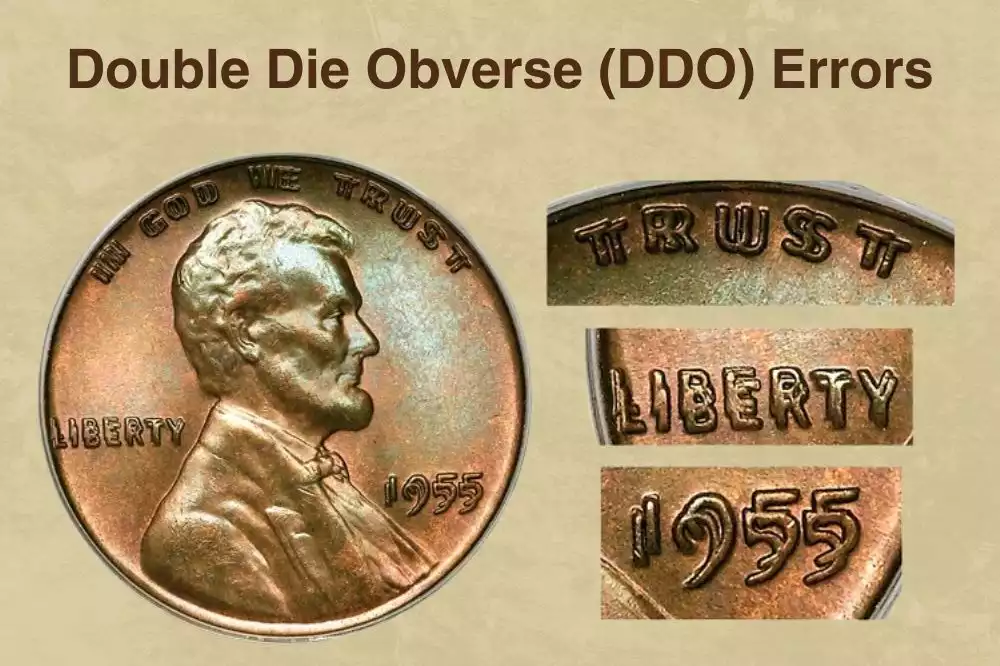
DDO errors form during the die-making process, specifically when creating working dies from master hubs. The Mint uses a stamp called a hub to create coin dies, and several generations of hubs are employed to craft the working dies that strike coins.
Doubled dies are created when the hub imprints an additional, misaligned image onto a die, and this occurred because before 1997, multiple impressions were required to transfer the design from hub to die.
After the first impression was made, the die was reheated and prepared for a second impression, with mint workers using guides to align the hub and working die perfectly to prevent overlapping. It is when mint workers failed to align dies properly during this process that doubled dies were produced.
This creates doubled images of letters, numbers, or design elements on the coin’s obverse side, with the misalignment occurring when the working hub impresses the design onto the working die more than once in slightly different positions. The result produces every coin struck from that defective die with identical doubling characteristics.
The 1958 DDO represents the pinnacle of wheat penny error values. The 1958 Doubled Die Obverse is the rarest and most valuable DDO error of the Lincoln Wheat Cent series, with only a handful known to exist and estimated values of $145,876 to $238,105 or more in uncirculated mint condition.
In January 2023, GreatCollections sold the finest known example — PCGS/CAC MS66 RD — for $1.136 million, the most ever realized for a Lincoln cent, and the first Lincoln to break $1 million at auction.
The 1955 DDO is also one of the most popular double die Lincoln penny examples, with doubling on the obverse inscriptions, particularly “LIBERTY” and “IN GOD WE TRUST,” that is unmistakable and visible even without magnification. Examples in mint state have surpassed $126,500 for this variety.
Known DDO Error Years for Wheat Lincoln Penny (1909–1958):
2. Doubled Die Reverse (DDR) Errors
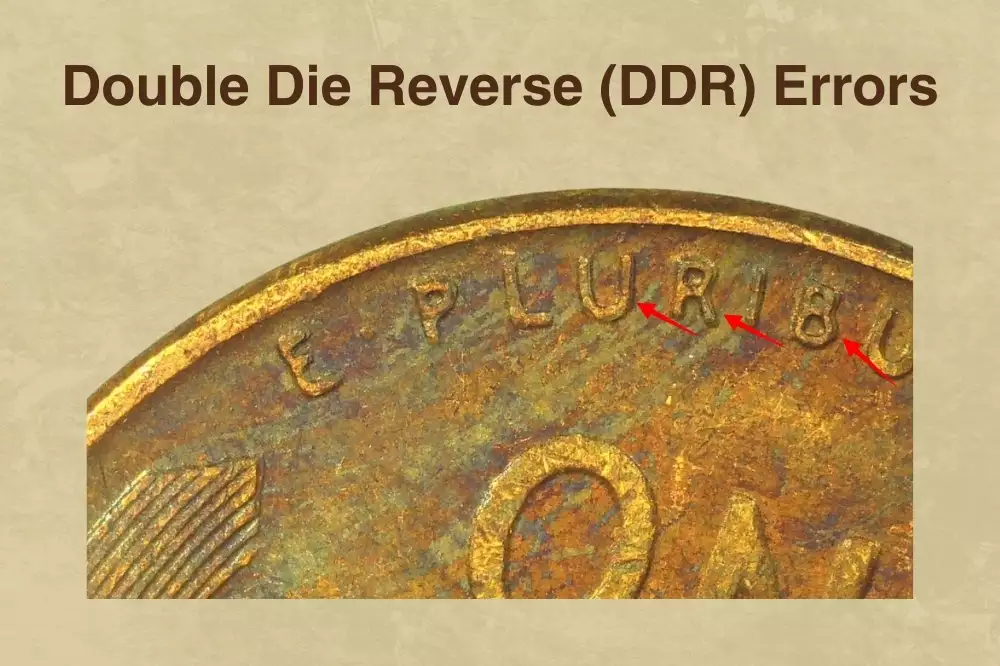
Double die is an error made during the stamping process when the die strikes the blank twice, resulting in duplicate design elements.
Doubled die coins are mainly created by a defective hub which is used to create many dies for the minting process. Collectors classify doubled dies as DDO (doubled die obverse coins), DDR (doubled die reverse) and OMM (over mint mark).
The DDR error occurs on the reverse (tails) side of the coin, following the same fundamental formation process as DDO errors. It happens during the die-making process when the working hub impresses the design onto the working die more than once in slightly different positions. With DDR errors, the doubling appears on the reverse side elements such as the wheat stalks, inscriptions like “ONE CENT” and “UNITED STATES OF AMERICA,” or other reverse design components.
The market for DDR Wheat Pennies is generally less established than their DDO counterparts, and premiums are generally lower than for DDO counterparts because the doubling on the reverse is often less dramatic and visible than obverse doubling. The wheat stalks and reverse inscriptions don’t create as striking a visual impact as doubled dates or “LIBERTY” inscriptions on the obverse.
Known DDR Error Years for Wheat Lincoln Penny (1909-1958):
3. Repunched Mintmark (RPM) Errors

Before the 1990’s mint marks were punched onto the die by use of a hand punch and were not initially part of the die’s design. The formation process involves manual die preparation where a die technician added missing elements by positioning a puncheon, a small steel rod with the mirror image of a letter or number on it, and striking the puncheon with a hammer pressing the image into the die.
A repunched mintmark error coin exhibits the same mintmark twice. This could be, say, a “D” or “S” — struck twice, and in 2 slightly different locations or angles. The error occurs when if the image is not strong enough, the technician will punch it a second time. Puncheons placed in a different position between strikes will produce a doubled image which is called a repunch.
RPMs are often designated as being a D over D, or S over S, in shorthand it would appear as: D/D S/S D/D/D (for a triple punching).
Repunched mintmarks can reflect any of the following mishaps: 1. A failure to position the letter punch precisely over a first attempt at punching in the letter. 2. A letter punch that bounces and lands lightly on the rebound. 3. A letter punch that is not held vertically.
The value of any particular RPM depends heavily on the visibility and distinctiveness of the repunching, the rarity of the specific variety, and the overall condition of the coin. More dramatic repunching that’s easily visible to collectors typically commands higher premiums.
Known RPM Error Years for Wheat Lincoln Penny (1909–1958):
4. Off-Center Strike Errors

An off-center error occurs at the United States Mint when a planchet is not properly positioned between the dies, and then the coin is struck resulting in the design being only partially struck on the planchet.
These errors occur when the planchet is improperly fed into the striking chamber and only sits partially on the collar, since the collar is responsible for holding the planchet in place during striking. If the planchet is not restricted by the collar and part of it falls outside the upper and lower dies, then an off-center strike occurs.
Sometimes the planchet is not properly fed through machinery and centered correctly on the die punches, so when that happens, only part of the design is imprinted on the blank with some area of the planchet left blank.
The initial round shape of the planchet can become substantially elongated during an off-center strike. This differs from misaligned die errors where the dies themselves are improperly positioned, as off-center strikes result from planchet positioning problems rather than die alignment issues.
The market value of off-center strike wheat pennies varies significantly based on the percentage of off-center displacement. Lincoln wheat penny 10% to 15% off center are worth $20+, 20% to 35% off center are worth $50+, and 40% to 60% off center are worth $200+.
These coins’ value depends on what percentage of the design is missing, and you can find them ranging from $5 to $100, with one 1958 specimen having a 20% off-center strike selling for $30 at auction.
The percentage off-center is important since 40% to 60% off-center is generally considered the “perfect” percentage because collectors want to see some design as well as some planchet. Generally speaking, a coin has to be struck at least 5% off center for it to register any significant value as an error coin, with the lettering near the edge needing to be at least partially cut off.
Known Off-Center Strike Error Years for Wheat Lincoln Penny (1909–1958):
5. Clipped Planchet Errors

Clipped planchet is one of the most well-known and popular coin errors, classified as a “planchet error” in the PDS (Planchet, Die, Striking) system used by numismatists. These error coins exhibit flat or crescent-shaped bites taken out of the side of a coin, making them easily recognizable to collectors.
The formation of clipped planchet errors occurs during the blank production stage at the U.S. Mint. When the coil stock overlaps during the process of punching metal planchets out of their parent metal, clipped planchet mistakes occur at the U.S. Mint. More specifically, a misfeed can occur when the metal strip is fed through the blanking machine, and the punches sometimes overlap the leading edge of the metal producing a straight clip.
The technical process involves feeding metal strips through blanking machines where circular punches cut out coin blanks. When the strip doesn’t advance properly or overlaps occur, the punches cut into areas where previous blanks were removed, creating the characteristic “clipped” appearance with missing metal sections.
The market value of clipped planchet Wheat Pennies varies significantly based on several factors. The penny values are determined by the clipped percentage and the state of the coin. Generally, values of collectable wheat pennies in good condition can range from several dollars to over $1000, though this applies to various error types and conditions.
For clipped planchet errors specifically, the value depends on:
- Percentage of clip: Larger clips (10-25% missing metal) typically command higher premiums
- Coin condition: Better preserved examples are worth significantly more
- Year and mintmark: Key dates within the Wheat series will have higher base values
- Type of clip: Straight clips, curved clips, and multiple clips each have different market appeal
Most common clipped planchet Wheat Pennies in average condition typically sell for $10-50, while exceptional examples or those from key dates can reach several hundred dollars.
Known Clipped Planchet Error Years for Wheat Lincoln Penny (1909–1958):
6. Lamination Errors
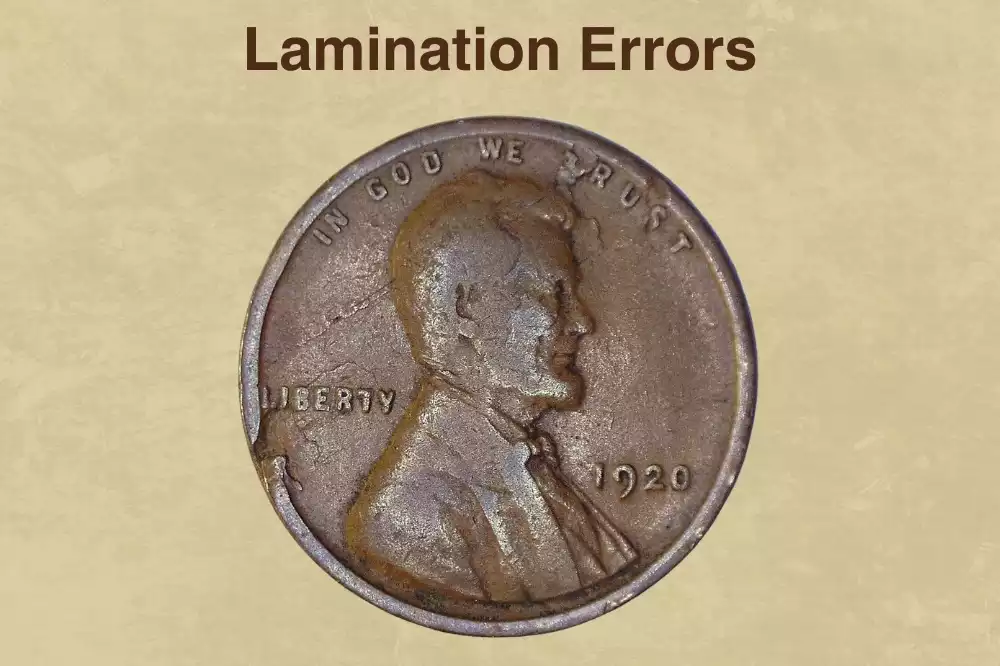
Lamination errors form during the early stages of planchet preparation when foreign materials or impurities become trapped within the metal structure.
During the preparation of the planchet strip, foreign materials like grease, dirt, oil, slag, or gas may become trapped just below the surface of the metal. A lamination is a planchet defect caused when a portion of the planchet metal separates from itself due to impurities or internal stresses.
Metallurgists aren’t quite sure why lamination flaws happen, but most believe that this error results from a planchet’s alloy being contaminated. Over time, coins with lamination flaws begin to peel or crack, with the crack actually being the coin peeling or splitting along its horizontal axis.
If too much grease is applied to the die, it can act like a suction cup, and as the die pulls away after pressing the coin, that added suction can easily remove any loose layers of metal, instantly creating a lamination error coin. These defects can manifest as peeling, flaking, bubbles, or missing metal patches on the coin’s surface.
The market value of lamination error wheat pennies varies considerably based on the severity and location of the defect. Lamination errors on 1945 cents typically sell for $90-160, with larger or more dramatic examples commanding premium prices. A 1919 wheat penny with a lamination crack on the obverse can sell for about $110, but this figure might increase depending on the coin’s condition and the extent of the crack.
Small laminations are fairly common on cents struck during the 1940s and 50s but do not command a high premium, and in some cases cause the value of the coin to be less, while larger laminations and larger denomination coins have higher values.
Known Lamination Error Years for Wheat Lincoln Penny (1909-1958):
7. Die Cracks Errors

A die crack occurs when a die, after being subjected to immense pressure during the minting process, cracks, causing a small gap in the die.
The working dies are heat treated to prepare them for the stresses of coin production, first heated to temperatures up to 1,800 degrees Fahrenheit, then quenched and tempered to reduce brittleness, but this process still makes them prone to cracking. Today, a single hardened steel die can stamp hundreds of thousands of coins before being retired from production, and the dies are subject to a lot of wear and tear.
When the dies strike planchets multiple times each day, over time the die can crack due to wear and tear, and when this happens, the cracked portion of the die is also engraved into the planchet. If this damaged die continues to produce coins, the metal will fill into the crack, thus revealing a raised line of metal in the finished coin. The formation represents the beginning stages of die failure before complete breakdown occurs.
The market value of Die Crack wheat pennies is generally modest compared to other error types. Die breaks that are small and minor are only worth $3 to $5, while spectacular die breaks are often worth more than $50 to $100.
Usually, some with drastic die cracks or die cracks on certain parts of the design such as areas near Lincoln’s face or between letters are more desirable and may be worth $5 to $10 or more.
Known Die Crack Error Years for Wheat Lincoln Penny (1909-1958):
8. S/S Over Horizontal S Errors

The S/S Over Horizontal S error is a specific type of Repunched Mintmark (RPM) error that occurs during the coin minting process.
During the pre-1990s era, mintmarks were hand-punched onto working dies at individual mint facilities. When a mintmark was initially placed incorrectly or needed repositioning, mint workers would punch a new mintmark over the original one.
The first mintmark was positioned horizontally, at 90 degrees to the second, creating a distinctive overlapping pattern where a normally oriented “S” mintmark is struck over a horizontally positioned “S” mintmark.
The horizontal orientation of the underlying mintmark distinguishes this particular variety from other S/S repunched mintmarks.
The market value varies of these coins significantly based on condition and the specific variety. The 1909 S Over Horizontal is worth $50 to $240 for uncirculated coins. This represents substantial value above the base coin’s worth, making it a sought-after error among collectors.
Known S/S Over Horizontal S Error Years for Wheat Lincoln Penny (1909-1958):
9. Die Clash Errors

A Die Clash is a specific type of mint error that occurs during the coin production process.
Die clashes form when the obverse (front) and reverse (back) dies come into direct contact during the minting process without a planchet (blank coin) positioned between them. This can happen due to mechanical malfunctions, operator error, or when the feeding mechanism fails to properly position a blank coin in the striking chamber.
When the dies strike each other, the raised design elements from each die create impressions on the opposing die face. This creates a distinctive visual effect where design elements from one side of the coin appear on the opposite side.
On Wheat Pennies, you might see traces of the wheat stalks appearing on Lincoln’s portrait side, or portions of Lincoln appearing on the reverse.
The market value of Die Clash errors on Wheat Pennies is generally modest compared to other error types. For most common date Wheat Pennies with die clash errors, expect values ranging from a few dollars to around $50-100 for well-preserved examples.
Known Die Clash Error Years for Wheat Lincoln Penny (1909-1958):
10. Struck Through Errors

A Struck Through error is a specific type of striking error that occurs during the coin minting process.
When a coin is struck, it should be produced from dies that are clean and free of any residues, debris, or other random objects so that when the dies come together to strike the planchet, a perfect strike will result. If, however, there is something between the dies or on the dies or planchet, a struck through error occurs.
Common materials that can cause struck through errors include cloth, fabric, grease, oil, metal fragments, lint or debris.
This error creates a distinctive appearance where foreign material prevents the dies from making complete contact with portions of the coin blank, resulting in missing or obscured design elements.
The severity and appearance of the error depend on the type, size, and position of the foreign material during striking. These errors can affect either the obverse (Lincoln side), reverse (wheat side), or both sides of the coin.
The market value of Struck Through errors on Wheat Pennies varies significantly based on several factors:
- Severity and visibility: More dramatic struck through effects command higher premiums
- Type of material: Certain types like cloth or significant debris are more desirable
- Coin condition: Higher grades increase value substantially
- Key dates: Struck through errors on scarce dates carry additional premiums
For most Wheat Pennies with struck through errors, values typically range from $10 to $100+ depending on the factors mentioned above. Particularly dramatic examples or those on key dates can command significantly higher prices, especially when professionally graded and authenticated.
Known Struck Through Error Years for Wheat Lincoln Penny (1909-1958):
11. Broadstrike Errors

A Broadstrike error occurs when a coin is struck without a collar, which is the retaining ring that establishes the final diameter of a newly struck coin.
The collar prevents the metal of the blank from flowing outside the confines of the die. During normal coin production, the collar acts as a containment system that maintains the coin’s proper diameter and creates the reeded or plain edge. When a broadstrike occurs, without a collar there is nothing to contain the coin as it is struck and the planchet expands to a diameter larger than that for a coin struck in a collar.
The visual characteristics are distinctive: They will usually have an incomplete edge with a missing or misshapen rim. There will probably be a lot of extra space between the inscriptions found near the rim of the coin (like the motto “IN GOD WE TRUST” as seen on the obverse of a Lincoln cent) and the edge of the coin.
The market value for broadstrike Wheat Pennies varies considerably from a few hundred to a few thousand dollars, based on several factors including the degree of expansion, centering, and overall condition. Error coins can be worth a mint as they are more rare than the ultra rare key date coins, which boost their desirability much higher amongst collectors everywhere.
Known Broadstrike Error Years for Wheat Lincoln Penny (1909-1958):
12. Multiple Strike Errors
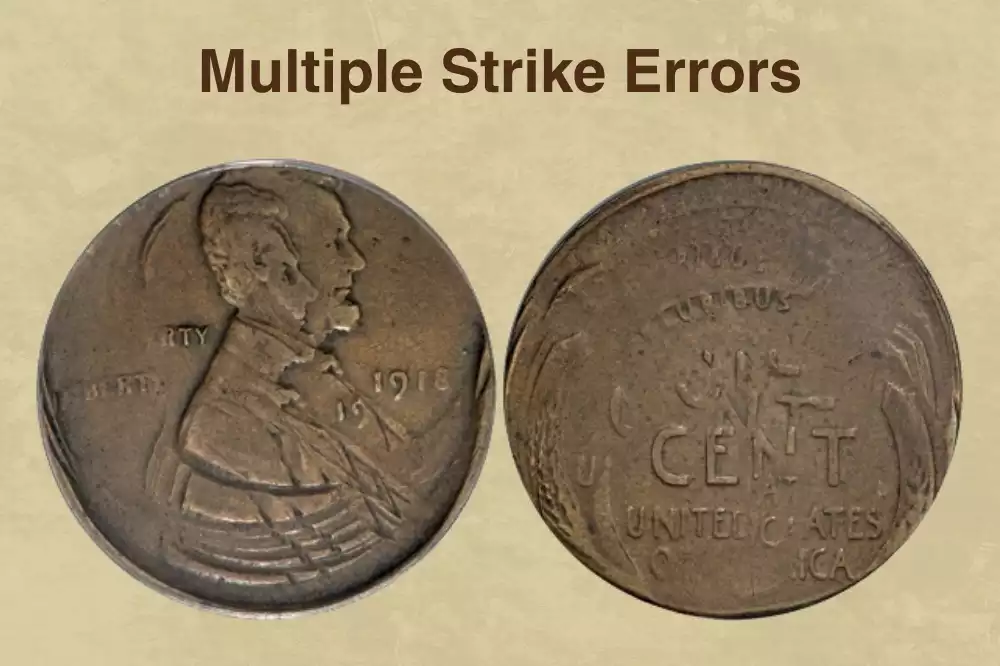
Multiple Strike errors form through a mechanical failure in the coin minting process. This occurs when a coin is struck correctly on the first attempt but fails to be ejected from between the dies due to problems with the coin press’s ejection system. The feeder finger, which places planchets between dies and ejects struck coins, malfunctions and doesn’t properly remove the coin from the die chamber.
When this happens, the coin receives additional images from being struck again, typically off-center, creating what’s sometimes called a “double exposure”. The dies continue to strike the coin a second, third, or more times until either the coin is finally ejected or a mint employee notices the press malfunction and stops the machine.
Sometimes coins move or rotate between strikes, creating clear evidence of multiple impressions with different orientations. The result is a coin bearing overlapping images from successive strikes, making it easily distinguishable from doubled die varieties, which are created during die manufacturing rather than the striking process.
Multiple Strike errors would likely command higher premiums than double strikes due to their dramatic appearance and rarity. Based on general mint error pricing patterns, Multiple Strike wheat pennies could potentially range from $50 to several hundred dollars depending on the number of strikes, condition, and specific year.
Known Multiple Strike Error Years for Wheat Lincoln Penny (1909-1958):
13. Weak “D” Errors
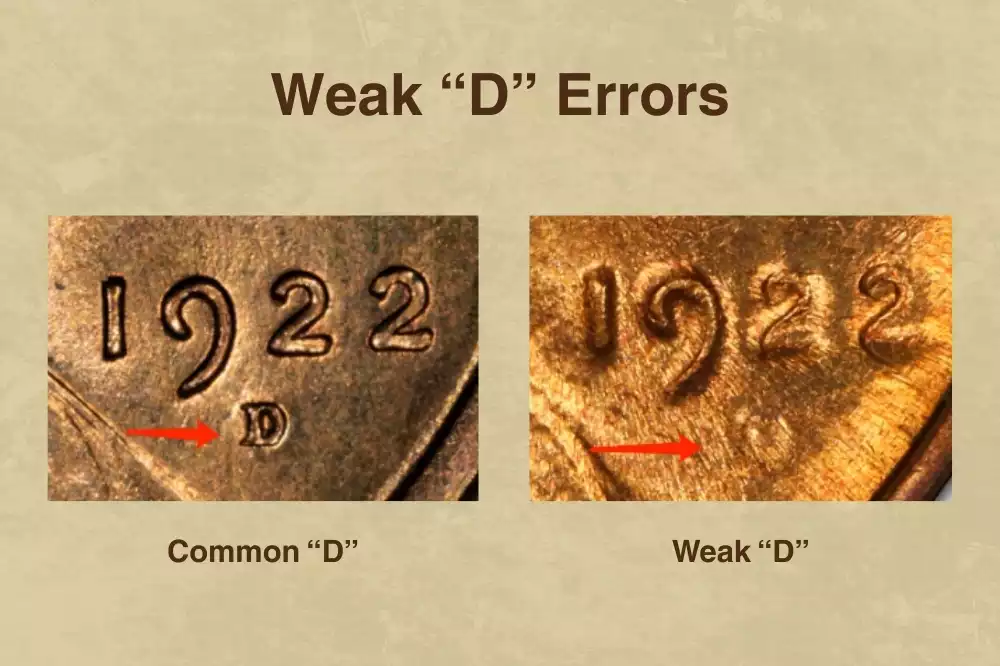
Weak “D” errors form through die deterioration and mechanical wear during the minting process. According to The Official Red Book, in 1922 the Denver mint struck pennies using heavily worn dies, resulting in many Lincoln cents with dull features and a “weak D” mintmark.
Historically, design elements like mintmarks were added by individual iron punches, where technicians positioned a small steel rod with the mirror image and struck it with a hammer to press the image into the die. If the image wasn’t strong enough initially, technicians would punch it a second time, but die wear over time could weaken these punched elements.
Missing or weak design elements can also occur because foreign matter like grease plugs the cavity into which the planchet’s metal would normally flow under striking pressure. The accumulation of debris in die recesses, combined with extensive die usage, gradually diminishes the clarity and strength of mintmarks, producing the characteristic “weak D” appearance where the mintmark is barely visible or partially formed.
A most famous example is the 1922 Weak D Lincoln cent, where heavily worn dies at Denver mint created both weak D varieties and complete “No D” varieties worth over $500 each even in fairly bad condition.
A 1956-D penny with a “shadowy D beneath the normal mintmark” would be worth between $10-$100 depending on condition, while regular 1956-D pennies are worth less than $1 even uncirculated.
Known Weak “D” Error Years for Wheat Lincoln Penny (1909-1958):
Final Words
Collecting wheat penny errors offers an incredibly rewarding journey that combines detective work, historical appreciation, and the thrill of discovery. These little copper treasures prove that sometimes imperfection creates the most perfect collectibles.
Whether you’re just starting out or you’re a seasoned numismatist, remember that your next valuable find might be sitting right in your pocket change—so keep those eyes peeled and that magnifying glass handy!
The post 13 Rare Lincoln Cent (Wheat Reverse) Errors Worth Money (Full List with Pictures) appeared first on CoinValueChecker.















